![]()
By Peter Vilhelm Nielsen
I first saw the art of Shi Hu five years ago, or more correctly I obtained a catalog with his ink drawings from a gallery. I immediately felt for his Chinese ink paintings. They were both traditional Chinese paintings but also very contemporary in style, very creative. Therefore, I was very fortunate to see that an exhibition was arranged at the Art Museum of Hong Kong University just when I arrived this year to the city and that Shi Hu was one of the artists. The exhibition has the title “My Three Friends”, and it is about three painters and their friendship with Kam-Ching Leung, the American Chinese owner of the collection.
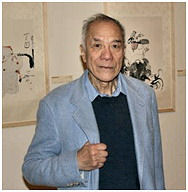
Kam-Ching Leung,
owner of the Shi Hu
collection
A talk with Kam-Ching Leung about the art and friendship with Shi Hu
Shi Hu was born in 1942 in Xushui, in the Hebei Province. He attended Beijing Arts and Craft School in 1958 and Zhejiang Fine Art Institute in 1960. In 1978 he toured thirteen countries in Africa, and Kam-Ching Leung befriended the artist in the 1980’s. Leung visited Shi Hu several times during the years and they had many discussions about art, poetry and the Chinese characters. In fact I learned that there is a strong connection between traditional Chinese art and the written Chinese characters.
Catherine Kwai writes in a catalog1: According to Shi Hu, modern art has evolved from folk art. He therefore advocates that artists should be able to draw their inspiration from folk art. His driving force for creation comes from Chinese traditional arts such as Wall painting, stone carving, lacquer painting, paper cutting embroidery and folk painting. His painting style is unique, as he has blended the characteristics of Chinese art with the techniques and concepts of different schools of art from the West. Shi Hu’s works express an unique spirit and mystery, yet at the same time, a shocking kind of grandeur and passion.
Kam-Ching Leung considers Shi Hu to be one of the most creative Chinese painters today. Some of his work combines the traditional ink drawings with modern Western composition. He makes line drawings that could be said to be strongly influenced by western art, but you could also argue that line drawing is the basis of Chinese drawings, and therefore an original concept. His use of calligraphy - his integration of writing and painting - has been developed to a very high level or to a major level taking into account the traditional values of Chinese poetry. He breaks rules and surprises us when something new comes to him.
The Chinese language has undergone some changes during the last 70 years. A fair number of characters have been simplified and the number of strokes in a character reduced. They are now represented by simple words of similar sounds. This simplification is supposed to make it easier to learn and print but it can destroy the expansive meaning of the characters and the possibility of expressing traditional text and poems. Shi Hu is a scholar. He is well versed in classical literature and calligraphy and integrates them into his art in a very free and contemporary way. In his art he employs traditional writing styles. He writes from top to bottom yet he can also write upside down and he develops the symbols and the layout of the text into the art itself.
Kam-Ching Leung also tells about their
discussions in arts and philosophy, and his work with Shi Hu in writing the
articles of “Spirit Awakening” dealing with the spirit of an art work and
getting multidimensional space into two-dimensional surface of a paper or a
canvas. Let us look into a number of paintings based on Chinese ink and
colour to see the different ways them Shi Hu use to express his art.
Two Tibetan Women 1980. This is one of the first paintings that Leung obtained from Shi Hu. It is painted on paper with black ink and Chinese colour, where the Chinese painting can either be in the form of ink colour or it can be a mineral colour, which is very expensive. The painting is much like an oil painting, and it has the traditional format with the height larger than the width. It is difficult to work in ink. You cannot change the painting, and the lines are dependent on the speed with which you use with the brush, as it is also described in article: “Contemporary Chinese ink and watercolour paintings – and the influence from the western traditions”2.
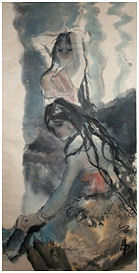
Two Tibetan Women 1980, 127 x 64.8 cm.
Girl in Bamboo Forest 1984. This painting is made in a period where the artist was experimenting with crumpling of the paper after it has been covered with a layer of paint and is still wet. Vertical folds become the basic of the bamboo, and other folds become the forest in general. The girl is sketched in a traditional and kind way.
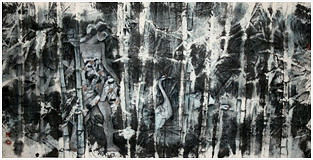
Girl in Bamboo Forest 1984, 87 x 170 cm.
Girl and Green Vine 1993. It is clearly a painting which combines a drawing with a printing technique where the leaves are formed by rubbing. It could be considered to be a modern western watercolour technique, but we must also consider that the use of rubbings is an important part of a traditional Chinese painting.
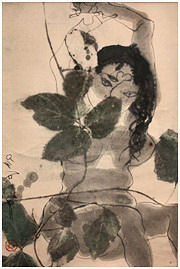
Girl and Green Vine 1993, 67.7 x 46 cm.
A Young Lady 1996. Kam-Ching Leung tells me that this painting is made in a period where Shi Hu worked with the effect of accidental patterns of ink. The ink pattern is probably made at first. Then the girl is painted afterward in the way that the grey colour (ink with plenty of water) is painted on the paper at first, and the line drawing is then made in pure ink after the bottom is dry. The patterns of ink, the calligraphy and Shi Hu’s stamp give the painting a very strong expression. Leung argues that the girl is a western girl, especially because of the dress and the pointed nose!
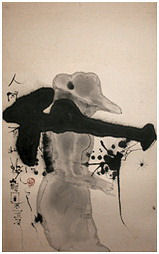
A Young Lady 1996, 95 x 59 cm.
Woman with Hen 1991. The style is more western and it looks as it is painted on a thicker paper than used in the other paintings. (In fact, many of the other ink and watercolour paintings are made on thin paper. Afterward they are glued on a larger paper, and the passepartout is covered by silk. The whole painting can then be rolled up for storing).
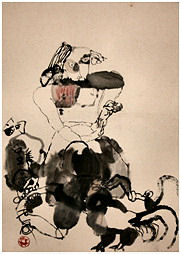
Woman with Hen 1991, 50 x 35 cm.
Welcome 1992. Shi Hu disappeared after the incident 4’th June in 1989. Leung met him again in 1992, and Shi Hu made this painting for him to celebrate the reunion. This is a painting made with black ink, watercolour, and probably acrylic paint. It is painted with brush, broom and pen. Western like and chaotic in style.

Welcome 1992, 136 x 69 cm.
Woman Bending Over 1991. This painting is an expressing of the freedom in showing a woman in a painting which is obtained in the recent years in China. Very different to “Girl in Bamboo Forest” from 1982. The calligraphy is beautiful and it says: “looking at the world you can see right here”. Does he mean what you can see, or what the lady in the painting can see?
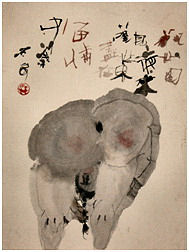
Woman Bending Over 1991, 48 x 36 cm.
A Boy with a Bull 2000. This is an ink drawing which shows influence from the western style, as e.g. Picasso, but we can also argue, as mentioned earlier, that line drawing is a traditional Chinese way of painting.

A Boy with a Bull 2000, 50 x 34 cm.
Five Happiness 1997. This piece of art is a work where poems, calligraphy and painting are merged. Generally the calligraphy is the sign of happiness. If you look into the four areas in the sign you can see the expression repeated four times, which gives the title: Five Happiness. One of the signs is showed upside down, and this is also becoming/receiving in Chinese , so the painting can also be seen as: Receiving Happiness. Then we also see a person in the painting, all made by black ink and large brush.
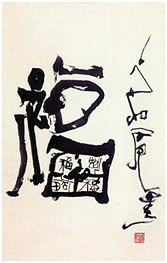
Five Happiness 1997, 78 x 49 cm.
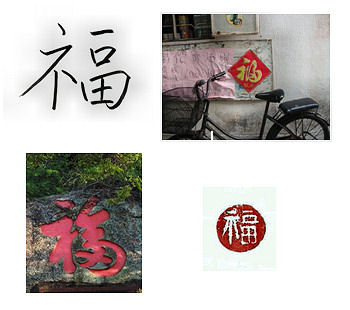
The happiness symbol is important during
Chinese New Year
where it is shown on many houses. The first symbol
shows
happiness written by hand and the next photo
show the text on a poster. The
carved symbol
is from a temple at the island Cheung Chan, and the
last
version of happiness is made by a Chinese stamp.
Calligraphy Couplet 1995. Two long texts to be read from right to left. They say: This bank is not too far you can cross. I do not realize that there are fishes in the water. They are made with strong movements, and certainly not painted with a fine brush, but perhaps a large bamboo pen or a broom like brush. The calligraphy is formed with a high level of sensitivity and sharp energy rather than traditional harmony. The large text is the poem. The smaller text was added when Shi Hu gave the painting to Kam-Ching Leung. It contains information as the name of the receiver, some comments, time when the painting was given to Leung, and name of painter as well as the painter’s stamp.
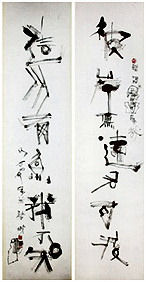
Calligraphy Couplet 1995, 136.5 x 34 cm.
A talk with Shi Hu should of course also
have been a part of this article, but Leung told me that he has gone into
seclusion again. Artists do that from time to time.
Anita Yin-fong Wong, Curator at University Museum & Art Gallery, has kindly
supported this article and Yvonne Leung has given valuable editorial
support.
The author like to express his thanks.
1 Wong, A., Paintings by Shi Hu, University
Museum and Art Gallery, The University of Hong Kong, 2000.
2 Nielsen, P. V., Contemporary Chinese ink and watercolour paintings – and the influence from the western traditions, Akvarellen nr. 4, 2009.
3 Leung, K-C., My Three Friends, Jian Gu Xuan Collection, Ding Han Art Center, 2009.
4 Leung, K-C. (Jian Gu Xuan), Collection of Chinese paintings and Calligraphy, Cheng Feng Museum of Art, China.